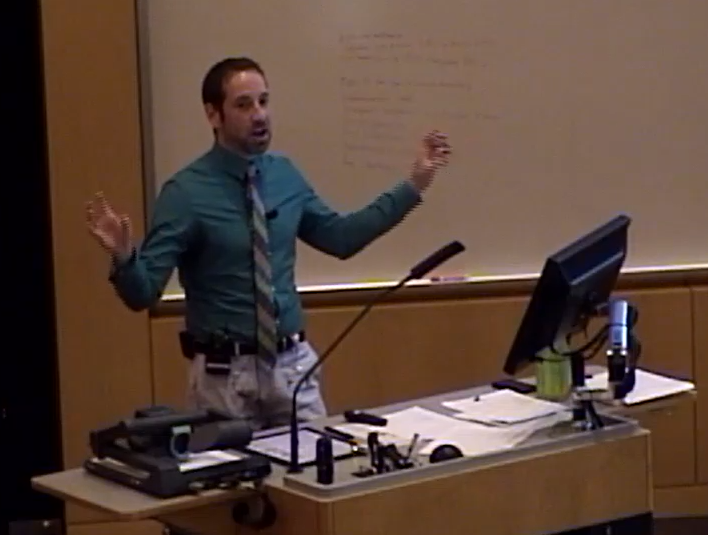Teaching & Education Philosophy

My approach to teaching is easy to summarize: get to know the learner, discover her needs, and facilitate the development of knowledge and skills — usually with a sense of humor. My approach to education is similarly easy to summarize: optimal learning is best accomplished actively, via a modernized, well-designed and executed, and continuously improving curriculum. Every day I integrate these two approaches to teaching and education in my journey to be a leader in medical education.
Learners across all levels who work with me note that I care intensely about what I’m doing, whether in treating patients or in a formal teaching setting. I model professional behaviors, and treat the learners like the adults that they are. I believe you have to want to learn – adults need to approach learning when their hearts and mind are in the right place. I try to do what I can to make learning fun, enjoyable, and memorable, even when the subject matter itself might be dry. My goal is to inspire a desire to learn, but I do expect learners to demonstrate some motivation and initiative. When working with learners whose clinical or scientific interests lie elsewhere, I try to focus their involvement on cases they would find relevant, such as having someone interested in neurology see my patient with aspirin allergy. Whenever possible, I get to know the learners so that I can tailor my teaching to their needs. In this way, while I never “pimp,” I make it clear that I will ask lots of non-threatening questions to determine baseline knowledge, so that I can focus on growth – to be a good teacher I need to know what the learner doesn’t know.
Learners who participate in curricula and sessions I have created will also note the thought and design detail that went into it. I provide guiding preparatory materials in order to emphasize active learning over those who desire basic content regurgitation. Those who grow the most from participating in my sessions have a desire to be challenged and will approach material with a sense of curiosity. Because I value understanding and applying concepts over memorization of minutiae, I design curricula to highlight basic knowledge architecture, pointing out the details which can be filled in or reviewed later. Learning activities are designed to reinforce mastery of material through spaced repetition, and often via modern technology – I frame knowledge with an awareness we all have google and smartphones at our fingertips.
In formalized educational sessions (large and small groups), my approach can be boiled down to, “Don’t be boring.” I like to walk around the room, vary my pace and volume, and ask students to read cases on my slides when appropriate. In my seminar at UIC, I created multiple-choice questions for learners to open and answer on their phone to encourage active participation with modern technology. I scattered cartoons, anecdotes, and emoji throughout the slides. I consider it a fun challenge in large lectures to keep learners awake and off their phones (unless directed to use them).
In clinic, I strive to teach everything beyond basic science – I believe most of the details of basic science will be better absorbed when learners sit down, read primary literature, pore over a table comparing and contrasting similar disease entities, or review a drug’s side effects vis-à-vis its pharmacologic mechanism. For example, while I may explain briefly the science of oral allergy syndrome to a learner, I place greater value on teaching how to explain the concepts to a patient, over any formal verbal “teaching” of which foods are associated with which pollens. Instead, I teach that there’s a table of oral allergy-pollen relationships, encouraging others to go learn on their own which pollen cause which fruits and vegetables to make a patient’s mouth itch. Thus, I usually try to take a shared clinical encounter and suggest a topic to go review; then come back to share their learning the next day, giving students something to focus on and placing a basic topic in the context of a clinical experience. This method lets me assess their professionalism on following through, evaluate communication skills either written or oral, and gauge understanding of what is taught back to me the next day. I know I often learn material better when I am at least partly self-directed and have prepared to teach to others, and hope my learners do the same.
Rather than prioritizing learning basic science in clinic, I make sure to dedicate clinic time with learners to a wide range of topics in outpatient medicine and patient care: using electronic medical records systems efficiently, ordering tests appropriately, determining appropriate follow-up, managing difficult patients, taking a focused history, narrowing differential diagnoses, communicating with nurses and medical assistants on the team, answering patients’ questions, and explaining disease processes to them. I emphasize that developing these types of skills will help in their current stages of training and future careers. By focusing on these various skills, I do my best to ensure nobody leaves clinic feeling they “haven’t learned anything” or “were not taught anything.” I believe developing a good repertoire of techniques in patient management is very important to learn, and emphasize this belief to those working with me in clinic.